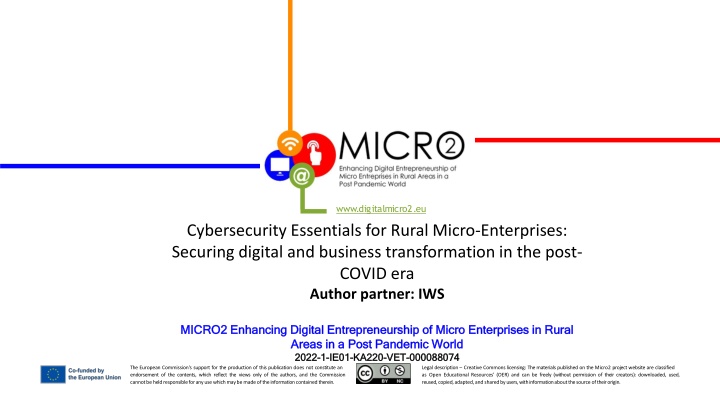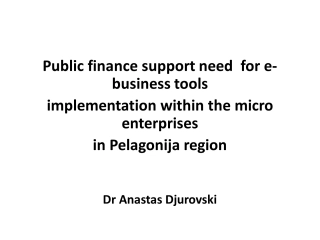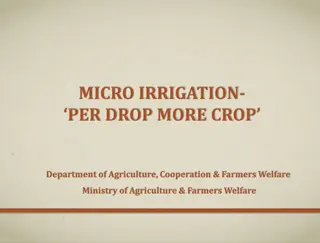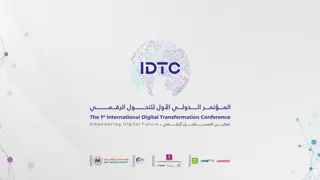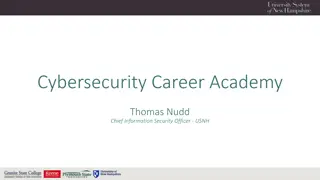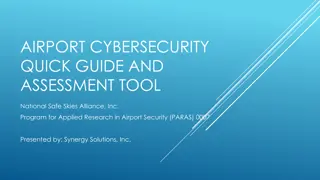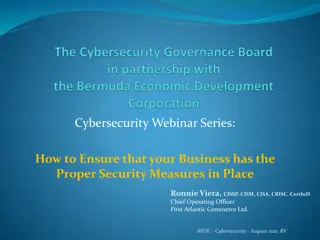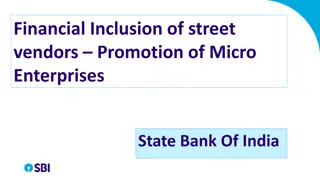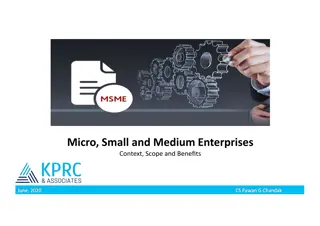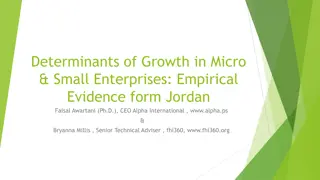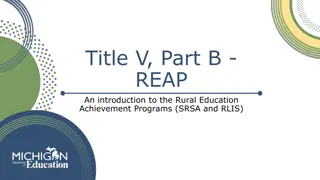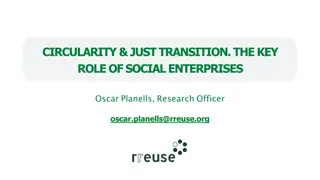Cybersecurity Essentials for Rural Micro-Enterprises: Securing Digital & Business Transformation in Post-COVID Era
This publication focuses on enhancing digital entrepreneurship of micro-enterprises in rural areas post-pandemic. It covers cybersecurity fundamentals, best practices, data protection measures, and remote work guidelines tailored for rural MSMEs. Readers will gain insights into mitigating cyber threats, securing business data, fostering security awareness, and evaluating security measures to safeguard digital assets and customer information.
Download Presentation

Please find below an Image/Link to download the presentation.
The content on the website is provided AS IS for your information and personal use only. It may not be sold, licensed, or shared on other websites without obtaining consent from the author.If you encounter any issues during the download, it is possible that the publisher has removed the file from their server.
You are allowed to download the files provided on this website for personal or commercial use, subject to the condition that they are used lawfully. All files are the property of their respective owners.
The content on the website is provided AS IS for your information and personal use only. It may not be sold, licensed, or shared on other websites without obtaining consent from the author.
E N D
Presentation Transcript
www.digitalmicro2.eu www.digitalmicro2.eu Cybersecurity Essentials for Rural Micro-Enterprises: Securing digital and business transformation in the post- COVID era Author partner: IWS MICRO2 MICRO2 Enhancing Digital Entrepreneurship of Micro Enterprises in Rural Enhancing Digital Entrepreneurship of Micro Enterprises in Rural Areas in a Post Pandemic World Areas in a Post Pandemic World 2022 2022- -1 1- -IE01 IE01- -KA220 KA220- -VET VET- -000088074 000088074 The European Commission's support for the production of this publication does not constitute an endorsement of the contents, which reflect the views only of the authors, and the Commission cannotbeheldresponsibleforanyusewhichmaybemadeoftheinformationcontainedtherein. Legal description Creative Commons licensing: Thematerials published on the Micro2 project website are classified as Open Educational Resources' (OER) and can be freely (without permission of their creators): downloaded, used, reused,copied,adapted,andsharedbyusers,withinformationaboutthesourceoftheirorigin.
www.digitalmicro2.eu www.digitalmicro2.eu Objectives and Goals Objectives and Goals At the end of this module, you will be able to: At the end of this module, you will be able to: - - - - - - - - Have a comprehensive understanding of cybersecurity essentials tailored to rural micro-enterprises. Identify and mitigate common cyber threats, reducing the risk of falling victim to cyberattacks. Have the capacity to secure business and customer data, fostering trust and reputation. Incorporate cybersecurity measures into their digital transformation journey. Reduce Cybersecurity Risks by fostering a proactive cybersecurity approach. Establish a culture of security awareness among their employees to collectively safeguard digital assets. Promote Remote Work Security to maintain cybersecurity while enabling remote work arrangements. Apply data protection strategies including encryption, access controls, and secure data storage to safeguard sensitive business and customer information. Assess cybersecurity risks, understand potential consequences of cyber incidents, and make informed decisions to mitigate those risks. Evaluate existing security measures and controls within the micro-enterprise, identifying areas for improvement and enhancement. - - The European Commission's support for the production of this publication does not constitute an endorsement of the contents, which reflect the views only of the authors, and the Commission cannotbeheldresponsibleforanyusewhichmaybemadeoftheinformationcontainedtherein. Legal description Creative Commons licensing: Thematerials published on the Micro2 project website are classified as Open Educational Resources' (OER) and can be freely (without permission of their creators): downloaded, used, reused,copied,adapted,andsharedbyusers,withinformationaboutthesourceoftheirorigin.
www.digitalmicro2.eu www.digitalmicro2.eu Index Index UNIT 1: Cybersecurity fundamentals for a smooth digital transformation of rural MSMEs UNIT 2: Cybersecurity Best practices to protect personal data and privacy Section 1.1. Identifying cyber threats and risks Section 2.1. Data Protection measures for rural MSMEs Section 1.2. Integrating cybersecurity measures in business activities Section 2.2. Remote work cybersecurity guidelines The European Commission's support for the production of this publication does not constitute an endorsement of the contents, which reflect the views only of the authors, and the Commission cannotbeheldresponsibleforanyusewhichmaybemadeoftheinformationcontainedtherein. Legal description Creative Commons licensing: Thematerials published on the Micro2 project website are classified as Open Educational Resources' (OER) and can be freely (without permission of their creators): downloaded, used, reused,copied,adapted,andsharedbyusers,withinformationaboutthesourceoftheirorigin.
Unit Unit 1 1 - - Cybersecurity fundamentals for a smooth digital transformation of rural MSMEs Cybersecurity fundamentals for a smooth digital transformation of rural MSMEs 1.1. 1.1. Identifying cyber threats and risk Identifying cyber threats and risk www.digitalmicro2.eu www.digitalmicro2.eu Cybersecurity fundamentals are essential for ensuring a smooth digital transformation of rural MSMEs. Rural microenterprises, like any other businesses, are vulnerable to a range of cyber threats and risks. While their scale might be smaller, the potential impact can still be significant. Here are the main cyber threats and risks that rural microenterprises should be aware of: Phishing Attacks: - Attackers send deceptive emails to trick employees into revealing sensitive information, such as login credentials or financial data. Malware Infections: - Malicious software (malware) includes viruses, ransomware, and spyware that can infiltrate systems, steal data, or lock files for ransom. Ransomware Attacks: - Ransomware encrypts files and demands payment for the decryption key, potentially causing data loss or business disruptions. The European Commission's support for the production of this publication does not constitute an endorsement of the contents, which reflect the views only of the authors, and the Commission cannotbeheldresponsibleforanyusewhichmaybemadeoftheinformationcontainedtherein. Legal description Creative Commons licensing: Thematerials published on the Micro2 project website are classified as Open Educational Resources' (OER) and can be freely (without permission of their creators): downloaded, used, reused,copied,adapted,andsharedbyusers,withinformationaboutthesourceoftheirorigin.
Unit Unit 1 1 - - Cybersecurity fundamentals for a smooth digital transformation of rural MSMEs Cybersecurity fundamentals for a smooth digital transformation of rural MSMEs 1.1. 1.1. Identifying cyber threats and risk Identifying cyber threats and risk www.digitalmicro2.eu www.digitalmicro2.eu Social Engineering: - Manipulating employees through psychological tactics to divulge confidential information or perform actions that compromise security. Insider Threats: - Unhappy employees or contractors with access to sensitive data can intentionally or unintentionally compromise security. Weak Passwords: - Insecure passwords make it easier for attackers to gain unauthorized access to systems and accounts. Unpatched Software: - Failure to apply software updates and patches can leave systems vulnerable to known security vulnerabilities. Lack of Data Encryption: - Unencrypted data can be intercepted during transmission, exposing sensitive information. The European Commission's support for the production of this publication does not constitute an endorsement of the contents, which reflect the views only of the authors, and the Commission cannotbeheldresponsibleforanyusewhichmaybemadeoftheinformationcontainedtherein. Legal description Creative Commons licensing: Thematerials published on the Micro2 project website are classified as Open Educational Resources' (OER) and can be freely (without permission of their creators): downloaded, used, reused,copied,adapted,andsharedbyusers,withinformationaboutthesourceoftheirorigin.
Unit Unit 1 1 - - Cybersecurity fundamentals for a smooth digital transformation of rural MSMEs Cybersecurity fundamentals for a smooth digital transformation of rural MSMEs 1.1. 1.1. Identifying cyber threats and risk Identifying cyber threats and risk www.digitalmicro2.eu www.digitalmicro2.eu Insecure Wi-Fi Networks: - Unsecured Wi-Fi networks can be exploited by attackers to eavesdrop on communications or launch attacks. Unauthorized Access: - Insufficient access controls can lead to unauthorized individuals gaining access to sensitive information or systems. Physical Theft of Devices: - Theft or loss of devices such as laptops or smartphones can result in data breaches if they contain sensitive information. Vendor and Third-Party Risks: - Cybersecurity weaknesses in third-party vendors can lead to supply chain attacks affecting microenterprises. Lack of Security Awareness: - Employees unaware of cybersecurity risks may inadvertently engage in risky online behavior. The European Commission's support for the production of this publication does not constitute an endorsement of the contents, which reflect the views only of the authors, and the Commission cannotbeheldresponsibleforanyusewhichmaybemadeoftheinformationcontainedtherein. Legal description Creative Commons licensing: Thematerials published on the Micro2 project website are classified as Open Educational Resources' (OER) and can be freely (without permission of their creators): downloaded, used, reused,copied,adapted,andsharedbyusers,withinformationaboutthesourceoftheirorigin.
Unit Unit 1 1 - - Cybersecurity fundamentals for a smooth digital transformation of rural MSMEs Cybersecurity fundamentals for a smooth digital transformation of rural MSMEs 1.1. 1.1. Identifying cyber threats and risk Identifying cyber threats and risk www.digitalmicro2.eu www.digitalmicro2.eu Data Breaches: - Exposure of customer or business data due to a breach can lead to legal, financial, and reputational consequences. Remote Work Vulnerabilities: - Remote work setups can introduce security vulnerabilities if proper cybersecurity measures are not implemented. Lack of Backup and Recovery: - Failure to regularly back up data can result in data loss during cyber incidents. Regulatory Non-Compliance: - Failure to comply with industry-specific regulations can result in legal penalties. Limited Resources for Cybersecurity: - Microenterprises may lack dedicated IT staff or budget for robust cybersecurity measures. The European Commission's support for the production of this publication does not constitute an endorsement of the contents, which reflect the views only of the authors, and the Commission cannotbeheldresponsibleforanyusewhichmaybemadeoftheinformationcontainedtherein. Legal description Creative Commons licensing: Thematerials published on the Micro2 project website are classified as Open Educational Resources' (OER) and can be freely (without permission of their creators): downloaded, used, reused,copied,adapted,andsharedbyusers,withinformationaboutthesourceoftheirorigin.
Unit Unit 1 1 - - Cybersecurity fundamentals for a smooth digital transformation of rural MSMEs Cybersecurity fundamentals for a smooth digital transformation of rural MSMEs 1.1. 1.1. Identifying cyber threats and risk Identifying cyber threats and risk www.digitalmicro2.eu www.digitalmicro2.eu IoT Vulnerabilities: - Internet of Things (IoT) devices can be compromised and used as entry points for attacks. Social Media Threats: - Sharing too much information on social media platforms can provide attackers with insights for crafting targeted attacks. To mitigate these risks, rural microenterprises should invest in cybersecurity education, implement robust security measures, maintain up-to-date software, and prioritize a proactive approach to cybersecurity. The European Commission's support for the production of this publication does not constitute an endorsement of the contents, which reflect the views only of the authors, and the Commission cannotbeheldresponsibleforanyusewhichmaybemadeoftheinformationcontainedtherein. Legal description Creative Commons licensing: Thematerials published on the Micro2 project website are classified as Open Educational Resources' (OER) and can be freely (without permission of their creators): downloaded, used, reused,copied,adapted,andsharedbyusers,withinformationaboutthesourceoftheirorigin.
Unit Unit 1 1 - - Cybersecurity fundamentals for a smooth digital transformation of rural MSMEs Cybersecurity fundamentals for a smooth digital transformation of rural MSMEs 1.2. Integrating cybersecurity measures in business activities 1.2. Integrating cybersecurity measures in business activities www.digitalmicro2.eu www.digitalmicro2.eu Integrating cybersecurity measures into business activities for rural microenterprises (MSMEs) is crucial to protect their digital assets and operations. In this sense, rural MSMEs should perform the following to protect their business from cyber threats: Risk Assessment and Management: Conduct a comprehensive risk assessment to identify potential cyber threats and vulnerabilities. Develop a risk management strategy that outlines how to mitigate, transfer, or accept risks. Security Awareness and Training: - Provide cybersecurity training to all employees to help them recognize and respond to cyber threats. Foster a culture of security awareness to ensure that security is everyone's responsibility. - The European Commission's support for the production of this publication does not constitute an endorsement of the contents, which reflect the views only of the authors, and the Commission cannotbeheldresponsibleforanyusewhichmaybemadeoftheinformationcontainedtherein. Legal description Creative Commons licensing: Thematerials published on the Micro2 project website are classified as Open Educational Resources' (OER) and can be freely (without permission of their creators): downloaded, used, reused,copied,adapted,andsharedbyusers,withinformationaboutthesourceoftheirorigin.
Unit Unit 1 1 - - Cybersecurity fundamentals for a smooth digital transformation of rural MSMEs Cybersecurity fundamentals for a smooth digital transformation of rural MSMEs 1.2. Integrating cybersecurity measures in business activities 1.2. Integrating cybersecurity measures in business activities www.digitalmicro2.eu www.digitalmicro2.eu Data Protection and Privacy: Implement strong data protection measures, including encryption, access controls, and data classification. Ensure compliance with data privacy regulations and communicate data usage policies to employees. Secure Network Infrastructure: Implement robust firewalls, intrusion detection systems, and intrusion prevention systems to safeguard the network. Endpoint Security: Install and regularly update antivirus and antimalware software on all devices. Enforce strong password policies and implement multi-factor authentication (MFA) for accessing systems. The European Commission's support for the production of this publication does not constitute an endorsement of the contents, which reflect the views only of the authors, and the Commission cannotbeheldresponsibleforanyusewhichmaybemadeoftheinformationcontainedtherein. Legal description Creative Commons licensing: Thematerials published on the Micro2 project website are classified as Open Educational Resources' (OER) and can be freely (without permission of their creators): downloaded, used, reused,copied,adapted,andsharedbyusers,withinformationaboutthesourceoftheirorigin.
Unit Unit 1 1 - - Cybersecurity fundamentals for a smooth digital transformation of rural MSMEs Cybersecurity fundamentals for a smooth digital transformation of rural MSMEs 1.2. Integrating cybersecurity measures in business activities 1.2. Integrating cybersecurity measures in business activities www.digitalmicro2.eu www.digitalmicro2.eu Secure Software Development: - - Follow secure coding practices to minimize vulnerabilities in software applications. Regularly update and patch software to address known security vulnerabilities. Backup and Recovery: - Regularly back up critical data and systems to ensure data can be restored in case of a cyber incident. Test the restoration process to verify the effectiveness of backups. - Incident Response Plan: - Develop a well-defined incident response plan that outlines steps to take in case of a cybersecurity incident. Designate roles and responsibilities for incident response team members. - The European Commission's support for the production of this publication does not constitute an endorsement of the contents, which reflect the views only of the authors, and the Commission cannotbeheldresponsibleforanyusewhichmaybemadeoftheinformationcontainedtherein. Legal description Creative Commons licensing: Thematerials published on the Micro2 project website are classified as Open Educational Resources' (OER) and can be freely (without permission of their creators): downloaded, used, reused,copied,adapted,andsharedbyusers,withinformationaboutthesourceoftheirorigin.
Unit Unit 1 1 - - Cybersecurity fundamentals for a smooth digital transformation of rural MSMEs Cybersecurity fundamentals for a smooth digital transformation of rural MSMEs 1.2. Integrating cybersecurity measures in business activities 1.2. Integrating cybersecurity measures in business activities www.digitalmicro2.eu www.digitalmicro2.eu Secure Cloud Adoption: - - Choose reputable cloud service providers with strong security measures. Implement proper access controls and encryption for data stored in the cloud. Vendor Risk Management: Assess and manage the cybersecurity risks associated with third-party vendors and partners. Include cybersecurity requirements in vendor contracts. Physical Security: Secure physical access to the premises where digital assets are located. Implement security measures such as access controls, surveillance, and visitor management. Regulatory Compliance: - - Stay informed about relevant cybersecurity regulations and industry standards. Ensure compliance with applicable regulations to avoid legal and financial consequences. The European Commission's support for the production of this publication does not constitute an endorsement of the contents, which reflect the views only of the authors, and the Commission cannotbeheldresponsibleforanyusewhichmaybemadeoftheinformationcontainedtherein. Legal description Creative Commons licensing: Thematerials published on the Micro2 project website are classified as Open Educational Resources' (OER) and can be freely (without permission of their creators): downloaded, used, reused,copied,adapted,andsharedbyusers,withinformationaboutthesourceoftheirorigin.
Unit Unit 1 1 - - Cybersecurity fundamentals for a smooth digital transformation of rural MSMEs Cybersecurity fundamentals for a smooth digital transformation of rural MSMEs 1.2. Integrating cybersecurity measures in business activities 1.2. Integrating cybersecurity measures in business activities www.digitalmicro2.eu www.digitalmicro2.eu Continuous Monitoring and Improvement: Regularly monitor systems and networks for signs of unauthorized access or suspicious activity. Continuously update and improve cybersecurity measures based on evolving threats. Security Audits and Assessments: Conduct regular security audits and assessments to identify weaknesses and areas for improvement. Use the results to enhance the cybersecurity posture of the organization. Employee Training and Awareness: Regularly train employees on cybersecurity best practices. Conduct workshops on identifying phishing emails and social engineering tactics. Promote a culture of security awareness through ongoing communication. The European Commission's support for the production of this publication does not constitute an endorsement of the contents, which reflect the views only of the authors, and the Commission cannotbeheldresponsibleforanyusewhichmaybemadeoftheinformationcontainedtherein. Legal description Creative Commons licensing: Thematerials published on the Micro2 project website are classified as Open Educational Resources' (OER) and can be freely (without permission of their creators): downloaded, used, reused,copied,adapted,andsharedbyusers,withinformationaboutthesourceoftheirorigin.
Unit Unit 1 1 - - Cybersecurity fundamentals for a smooth digital transformation of rural MSMEs Cybersecurity fundamentals for a smooth digital transformation of rural MSMEs 1.2. Integrating cybersecurity measures in business activities 1.2. Integrating cybersecurity measures in business activities www.digitalmicro2.eu www.digitalmicro2.eu Strong Password Policies: Enforce strong password policies for all accounts. Use password managers to generate and store complex passwords. Enable multi-factor authentication (MFA) for added security. Regular Software Updates: - - Set up automatic updates for operating systems and software. Apply security patches promptly to address known vulnerabilities. Firewall and Network Segmentation: Install firewalls to filter incoming and outgoing network traffic. Segment the network to restrict access to sensitive systems. Endpoint Protection: Install and update antivirus and antimalware software on all devices. Use endpoint detection and response (EDR) tools for real-time threat monitoring. The European Commission's support for the production of this publication does not constitute an endorsement of the contents, which reflect the views only of the authors, and the Commission cannotbeheldresponsibleforanyusewhichmaybemadeoftheinformationcontainedtherein. Legal description Creative Commons licensing: Thematerials published on the Micro2 project website are classified as Open Educational Resources' (OER) and can be freely (without permission of their creators): downloaded, used, reused,copied,adapted,andsharedbyusers,withinformationaboutthesourceoftheirorigin.
Unit Unit 1 1 - - Cybersecurity fundamentals for a smooth digital transformation of rural MSMEs Cybersecurity fundamentals for a smooth digital transformation of rural MSMEs 1.2. Integrating cybersecurity measures in business activities 1.2. Integrating cybersecurity measures in business activities www.digitalmicro2.eu www.digitalmicro2.eu Data Encryption: - - Encrypt sensitive data both during transmission and storage. Implement encryption for emails, databases, and files. Cyber Insurance: - Consider purchasing cyber insurance to cover financial losses from cyber incidents. User Access Controls: - - Assign permissions based on the principle of least privilege. Regularly review and revoke unnecessary access rights. Patch Management: - - Implement a patch management process to ensure timely updates. Test patches before deployment to prevent system disruptions. The European Commission's support for the production of this publication does not constitute an endorsement of the contents, which reflect the views only of the authors, and the Commission cannotbeheldresponsibleforanyusewhichmaybemadeoftheinformationcontainedtherein. Legal description Creative Commons licensing: Thematerials published on the Micro2 project website are classified as Open Educational Resources' (OER) and can be freely (without permission of their creators): downloaded, used, reused,copied,adapted,andsharedbyusers,withinformationaboutthesourceoftheirorigin.
Unit Unit 1 1 - - Cybersecurity fundamentals for a smooth digital transformation of rural MSMEs Cybersecurity fundamentals for a smooth digital transformation of rural MSMEs 1.2. Integrating cybersecurity measures in business activities 1.2. Integrating cybersecurity measures in business activities www.digitalmicro2.eu www.digitalmicro2.eu Security Awareness Programs: - - Conduct ongoing security awareness programs to educate employees. Provide resources like posters, newsletters, and training materials. Cybersecurity Policies and Procedures: Develop and document cybersecurity policies and procedures. Clearly communicate these policies to all employees. Integration of these measures requires commitment from leadership, ongoing employee training, and a proactive approach to cybersecurity. Regular assessment and adaptation are essential to address emerging threats and maintain a secure digital environment for rural MSMEs. By implementing these cybersecurity fundamentals, rural MSMEs can transform digitally with confidence, knowing that their digital assets, customer data, and operations are secure against cyber threats. The European Commission's support for the production of this publication does not constitute an endorsement of the contents, which reflect the views only of the authors, and the Commission cannotbeheldresponsibleforanyusewhichmaybemadeoftheinformationcontainedtherein. Legal description Creative Commons licensing: Thematerials published on the Micro2 project website are classified as Open Educational Resources' (OER) and can be freely (without permission of their creators): downloaded, used, reused,copied,adapted,andsharedbyusers,withinformationaboutthesourceoftheirorigin.
Unit Unit 2 2 - - Cybersecurity Best practices to protect personal data and privacy Cybersecurity Best practices to protect personal data and privacy 2.1. Data Protection measures for rural MSMEs 2.1. Data Protection measures for rural MSMEs www.digitalmicro2.eu www.digitalmicro2.eu Data protection is a key concept for all MSMEs being them rural or urban to safeguard sensitive business and customer information. Apart from the general cybersecurity measures that we have mentioned so far, there is a series of specific data protection measures that rural MSMEs should implement to strengthen their data protection efforts, such as: Data Classification: - - Classify data based on its sensitivity and importance. Apply appropriate security measures based on data classification. Implement Encryption: - - Encrypt sensitive data both at rest and during transmission. Use encryption tools to protect customer information and business secrets. Access Controls: - - Implement role-based access controls (RBAC) to restrict data access. Grant access only to authorized personnel based on their job roles. The European Commission's support for the production of this publication does not constitute an endorsement of the contents, which reflect the views only of the authors, and the Commission cannotbeheldresponsibleforanyusewhichmaybemadeoftheinformationcontainedtherein. Legal description Creative Commons licensing: Thematerials published on the Micro2 project website are classified as Open Educational Resources' (OER) and can be freely (without permission of their creators): downloaded, used, reused,copied,adapted,andsharedbyusers,withinformationaboutthesourceoftheirorigin.
Unit Unit 2 2 - - Cybersecurity Best practices to protect personal data and privacy Cybersecurity Best practices to protect personal data and privacy 2.1. Data Protection measures for rural MSMEs 2.1. Data Protection measures for rural MSMEs www.digitalmicro2.eu www.digitalmicro2.eu Regular Data Backups: Regularly back up critical data to secure offsite locations. Test data restoration to ensure backups are viable in case of data loss. Secure Data Disposal: Develop procedures for securely disposing of old hardware and storage devices. Use data wiping tools to ensure data cannot be recovered. User Training: - - Educate employees about the importance of data protection. Train them on secure data handling practices, such as not sharing passwords. Security Policies: - - Develop data protection and privacy policies. Clearly communicate these policies to all employees. The European Commission's support for the production of this publication does not constitute an endorsement of the contents, which reflect the views only of the authors, and the Commission cannotbeheldresponsibleforanyusewhichmaybemadeoftheinformationcontainedtherein. Legal description Creative Commons licensing: Thematerials published on the Micro2 project website are classified as Open Educational Resources' (OER) and can be freely (without permission of their creators): downloaded, used, reused,copied,adapted,andsharedbyusers,withinformationaboutthesourceoftheirorigin.
Unit Unit 2 2 - - Cybersecurity Best practices to protect personal data and privacy Cybersecurity Best practices to protect personal data and privacy 2.1. Data Protection measures for rural MSMEs 2.1. Data Protection measures for rural MSMEs www.digitalmicro2.eu www.digitalmicro2.eu Data Minimization: - - Collect and retain only the data necessary for business operations. Delete outdated or unnecessary data. Employee Accountability: - - Hold employees accountable for adhering to data protection policies. Implement consequences for violating data protection rules. Monitoring and Logging: - - Implement monitoring tools to track data access and usage. Maintain logs for auditing and incident investigations. Secure Remote Work: - - Provide guidelines for securing data when working remotely. Encourage the use of virtual private networks (VPNs) for secure connections. The European Commission's support for the production of this publication does not constitute an endorsement of the contents, which reflect the views only of the authors, and the Commission cannotbeheldresponsibleforanyusewhichmaybemadeoftheinformationcontainedtherein. Legal description Creative Commons licensing: Thematerials published on the Micro2 project website are classified as Open Educational Resources' (OER) and can be freely (without permission of their creators): downloaded, used, reused,copied,adapted,andsharedbyusers,withinformationaboutthesourceoftheirorigin.
Unit Unit 2 2 - - Cybersecurity Best practices to protect personal data and privacy Cybersecurity Best practices to protect personal data and privacy 2.1. Data Protection measures for rural MSMEs 2.1. Data Protection measures for rural MSMEs www.digitalmicro2.eu www.digitalmicro2.eu Data Retention Policies: Establish policies for how long different types of data should be retained. Delete data that is no longer needed. Continuous Improvement: - - Regularly review and update data protection measures based on emerging threats. Stay informed about best practices and new technologies. By implementing these measures, rural MSMEs can significantly enhance their data protection efforts, minimizing the risk of data breaches and ensuring the trust of their customers and partners. The European Commission's support for the production of this publication does not constitute an endorsement of the contents, which reflect the views only of the authors, and the Commission cannotbeheldresponsibleforanyusewhichmaybemadeoftheinformationcontainedtherein. Legal description Creative Commons licensing: Thematerials published on the Micro2 project website are classified as Open Educational Resources' (OER) and can be freely (without permission of their creators): downloaded, used, reused,copied,adapted,andsharedbyusers,withinformationaboutthesourceoftheirorigin.
Unit Unit 2 2 - - Cybersecurity Best practices to protect personal data and privacy Cybersecurity Best practices to protect personal data and privacy 2.2. Remote work cybersecurity guidelines 2.2. Remote work cybersecurity guidelines www.digitalmicro2.eu www.digitalmicro2.eu In today's evolving work landscape, where remote work has become a prevalent practice, it's imperative for rural Micro, Small, and Medium Enterprises (MSMEs) to prioritize cybersecurity. This is crucial not only for maintaining the integrity of their operations but also for safeguarding sensitive information while their employees operate outside the conventional office environment. Let's delve into the essential remote work cybersecurity guidelines that these rural businesses should consider adopting: 1. Use Secure Connections: In this era of digital connectivity, emphasizing the use of virtual private networks (VPNs) is vital. VPNs provide a secure tunnel for data transmission over the internet, effectively encrypting the information being exchanged. Encouraging employees to use VPNs while accessing corporate systems adds an extra layer of protection against potential cyber threats. 2. Multi-Factor Authentication (MFA): An additional layer of security can be established through the implementation of Multi-Factor Authentication (MFA). This approach ensures that accessing sensitive corporate accounts requires multiple forms of verification, such as a password and a unique code sent to the user's mobile device. This simple but effective measure reduces the risk of unauthorized access. The European Commission's support for the production of this publication does not constitute an endorsement of the contents, which reflect the views only of the authors, and the Commission cannotbeheldresponsibleforanyusewhichmaybemadeoftheinformationcontainedtherein. Legal description Creative Commons licensing: Thematerials published on the Micro2 project website are classified as Open Educational Resources' (OER) and can be freely (without permission of their creators): downloaded, used, reused,copied,adapted,andsharedbyusers,withinformationaboutthesourceoftheirorigin.
Unit Unit 2 2 - - Cybersecurity Best practices to protect personal data and privacy Cybersecurity Best practices to protect personal data and privacy 2.2. Remote work cybersecurity guidelines 2.2. Remote work cybersecurity guidelines www.digitalmicro2.eu www.digitalmicro2.eu 3. Secure Device Usage: Supplying employees with company-issued devices equipped with up-to-date security software is a foundational step. This ensures that all devices are consistently protected against emerging threats. Additionally, discouraging the use of public computers or shared devices for work-related tasks prevents potential compromise of sensitive data. 4. Regular Software Updates: The importance of regularly updating operating systems, applications, and security software cannot be stressed enough. These updates typically include patches that address known vulnerabilities. Keeping software current guards against potential exploits by cybercriminals. 5. Secure Wi-Fi Connections: Guiding employees to connect to secure, password-protected Wi-Fi networks is vital. This practice prevents unauthorized access to data while working remotely. Simultaneously, steering clear of open public Wi-Fi networks for work tasks minimizes exposure to potential attacks. 6. Strong Passwords: Enforcing the usage of strong, unique passwords for work-related accounts is a fundamental practice. This prevents brute-force attacks and unauthorized access attempts. Discouraging password sharing and reuse across various accounts further enhances security. The European Commission's support for the production of this publication does not constitute an endorsement of the contents, which reflect the views only of the authors, and the Commission cannotbeheldresponsibleforanyusewhichmaybemadeoftheinformationcontainedtherein. Legal description Creative Commons licensing: Thematerials published on the Micro2 project website are classified as Open Educational Resources' (OER) and can be freely (without permission of their creators): downloaded, used, reused,copied,adapted,andsharedbyusers,withinformationaboutthesourceoftheirorigin.
Unit Unit 2 2 - - Cybersecurity Best practices to protect personal data and privacy Cybersecurity Best practices to protect personal data and privacy 2.2. Remote work cybersecurity guidelines 2.2. Remote work cybersecurity guidelines www.digitalmicro2.eu www.digitalmicro2.eu 7. Data Encryption: Underlining the significance of encrypting sensitive data both during transmission and storage is pivotal. Encryption transforms data into unreadable code, rendering it useless to anyone who may intercept it. Encouraging the use of encrypted communication tools for confidential conversations fortifies security. 8. Phishing Awareness: Educating employees about recognizing phishing emails and other social engineering attacks is a proactive measure. Highlighting the risks associated with clicking on suspicious links or downloading attachments from unfamiliar sources can prevent potential breaches. 9. Secure File Sharing: Suggesting the use of company-approved file-sharing tools equipped with robust encryption and access controls ensures that sensitive files are exchanged securely. Conversely, discouraging the sharing of confidential files through personal email or cloud services helps prevent data leaks. 10. Physical Security: Emphasizing the need to secure work devices when not in use and keeping work-related materials out of sight from unauthorized individuals mitigates physical security risks. This is especially relevant for remote workers who operate in diverse environments. The European Commission's support for the production of this publication does not constitute an endorsement of the contents, which reflect the views only of the authors, and the Commission cannotbeheldresponsibleforanyusewhichmaybemadeoftheinformationcontainedtherein. Legal description Creative Commons licensing: Thematerials published on the Micro2 project website are classified as Open Educational Resources' (OER) and can be freely (without permission of their creators): downloaded, used, reused,copied,adapted,andsharedbyusers,withinformationaboutthesourceoftheirorigin.
Unit Unit 2 2 - - Cybersecurity Best practices to protect personal data and privacy Cybersecurity Best practices to protect personal data and privacy 2.2. Remote work cybersecurity guidelines 2.2. Remote work cybersecurity guidelines www.digitalmicro2.eu www.digitalmicro2.eu 11. Data Backup: Educating employees about the importance of regularly backing up work data to a secure location is a prudent practice. This prepares businesses to quickly recover in the event of data loss due to cyber incidents or other unforeseen events. 12. Secure Video Conferencing: Selecting video conferencing platforms that employ end-to-end encryption ensures that discussions remain confidential. Implementing security features such as meeting passwords and waiting rooms adds an extra layer of control over who can access these virtual meetings. 13. Use Official Communication Channels: Promoting the use of company-approved communication tools for work-related discussions establishes a controlled environment for sharing information. Discouraging the discussion of sensitive matters on personal messaging platforms minimizes the risk of data exposure. 14. Remote Desktop Protocol (RDP) Security: If Remote Desktop Protocol (RDP) is employed, it's essential to secure it with strong passwords and access controls. Using a VPN in conjunction with RDP adds an additional layer of protection against unauthorized access. The European Commission's support for the production of this publication does not constitute an endorsement of the contents, which reflect the views only of the authors, and the Commission cannotbeheldresponsibleforanyusewhichmaybemadeoftheinformationcontainedtherein. Legal description Creative Commons licensing: Thematerials published on the Micro2 project website are classified as Open Educational Resources' (OER) and can be freely (without permission of their creators): downloaded, used, reused,copied,adapted,andsharedbyusers,withinformationaboutthesourceoftheirorigin.
Unit Unit 2 2 - - Cybersecurity Best practices to protect personal data and privacy Cybersecurity Best practices to protect personal data and privacy 2.2. Remote work cybersecurity guidelines 2.2. Remote work cybersecurity guidelines www.digitalmicro2.eu www.digitalmicro2.eu 15. Security Training: Conducting regular cybersecurity training sessions keeps employees well-informed about evolving threats and best practices. This empowers them to make informed decisions and enhances the overall security posture of the organization. 16. Incident Reporting: Establishing clear procedures for reporting cybersecurity incidents or suspicious activities ensures that any potential breaches are promptly addressed. Employees should be aware of whom to contact in the event of a security breach. 17. Remote Work Policy: Developing and communicating a comprehensive remote work policy that outlines security expectations and guidelines provides employees with a clear understanding of their responsibilities. This fosters a secure remote work environment. 18. Continuous Monitoring: Implementing monitoring tools that can detect and respond to security incidents in real-time is crucial. Regularly reviewing remote access logs for unauthorized activities enables proactive threat detection and mitigation. The European Commission's support for the production of this publication does not constitute an endorsement of the contents, which reflect the views only of the authors, and the Commission cannotbeheldresponsibleforanyusewhichmaybemadeoftheinformationcontainedtherein. Legal description Creative Commons licensing: Thematerials published on the Micro2 project website are classified as Open Educational Resources' (OER) and can be freely (without permission of their creators): downloaded, used, reused,copied,adapted,andsharedbyusers,withinformationaboutthesourceoftheirorigin.
Unit Unit 2 2 - - Cybersecurity Best practices to protect personal data and privacy Cybersecurity Best practices to protect personal data and privacy 2.2. Remote work cybersecurity guidelines 2.2. Remote work cybersecurity guidelines www.digitalmicro2.eu www.digitalmicro2.eu 19. Regular Check-ins: Maintaining consistent communication with remote employees serves multiple purposes. It not only addresses security concerns but also provides ongoing support, reinforcing a sense of connectivity even in remote work settings. 20. Compliance with Regulations: Ensuring that remote work practices align with pertinent data protection and privacy regulations is non-negotiable. Adhering to these regulations safeguards both the business and its clients' sensitive information. By diligently adhering to these remote work cybersecurity guidelines, rural MSMEs can enable their employees to work remotely without compromising data security. These measures collectively contribute to minimizing the risk of cyber threats and maintaining a robust level of security, even in the context of a dispersed work environment. The European Commission's support for the production of this publication does not constitute an endorsement of the contents, which reflect the views only of the authors, and the Commission cannotbeheldresponsibleforanyusewhichmaybemadeoftheinformationcontainedtherein. Legal description Creative Commons licensing: Thematerials published on the Micro2 project website are classified as Open Educational Resources' (OER) and can be freely (without permission of their creators): downloaded, used, reused,copied,adapted,andsharedbyusers,withinformationaboutthesourceoftheirorigin.
www.digitalmicro2.eu www.digitalmicro2.eu Summing up Summing up Cybersecurity fundamentals are essential for ensuring a smooth digital transformation of rural MSMEs. Rural microenterprises, like any other businesses, are vulnerable to a range of cyber threats and risks. While their scale might be smaller, the potential impact can still be significant. Integrating cybersecurity measures into business activities for rural microenterprises (MSMEs) is crucial to protect their digital assets and operations. Unit 1 Data protection is a key concept for all MSMEs being them rural or urban to safeguard sensitive business and customer information. Remote work has become a prevalent practice also for rural Micro, Small, and Medium Enterprises (MSMEs) therefore it is crucial to have internal cybersecurity guidelines not only for maintaining the integrity of their operations but also for safeguarding sensitive information while their employees operate outside the conventional office environment. Unit 2 The European Commission's support for the production of this publication does not constitute an endorsement of the contents, which reflect the views only of the authors, and the Commission cannotbeheldresponsibleforanyusewhichmaybemadeoftheinformationcontainedtherein. Legal description Creative Commons licensing: Thematerials published on the Micro2 project website are classified as Open Educational Resources' (OER) and can be freely (without permission of their creators): downloaded, used, reused,copied,adapted,andsharedbyusers,withinformationaboutthesourceoftheirorigin.
www.digitalmicro2.eu www.digitalmicro2.eu Self Self- -assessment questions assessment questions What type of cyber attack involves attackers sending deceptive emails to trick employees into revealing sensitive information? Which type of cyber attack involves encrypting files and demanding payment for the decryption key? What is the primary purpose of conducting a risk assessment in cybersecurity? What is the purpose of classifying data based on its sensitivity and importance? What is the purpose of regularly backing up critical data? How does a Virtual Private Network (VPN) enhance remote work security? a) Malware Infections b) Ransomware Attacks c) Insider Threats d) Phishing Attacks a) Phishing Attacks b) Social Engineering c) Ransomware Attacks d) Malware Infections a) To increase cyber threats b) To identify potential cyber threats and vulnerabilities c) To eliminate all cyber risks d) To create new security vulnerabilities a) To make data easier to access b) To apply appropriate security measures based on data classification c) To increase data retention policies d) To eliminate data encryption needs a) To eliminate the need for data encryption b) To prevent software updates c) To ensure data can be restored in case of data loss d) To speed up network performance a) It increases data sharing b) It eliminates the need for multi-factor authentication c) It provides a secure tunnel for data transmission d) It encourages open public Wi-Fi network usage The European Commission's support for the production of this publication does not constitute an endorsement of the contents, which reflect the views only of the authors, and the Commission cannotbeheldresponsibleforanyusewhichmaybemadeoftheinformationcontainedtherein. Legal description Creative Commons licensing: Thematerials published on the Micro2 project website are classified as Open Educational Resources' (OER) and can be freely (without permission of their creators): downloaded, used, reused,copied,adapted,andsharedbyusers,withinformationaboutthesourceoftheirorigin.
www.digitalmicro2.eu www.digitalmicro2.eu Thank Thank you! you! https://www.digitalmicro2.eu/ Continue your training path at Continue your training path at https://www.digitalmicro2.eu/ The European Commission's support for the production of this publication does not constitute an endorsement of the contents, which reflect the views only of the authors, and the Commission cannotbeheldresponsibleforanyusewhichmaybemadeoftheinformationcontainedtherein. Legal description Creative Commons licensing: Thematerials published on the Micro2 project website are classified as Open Educational Resources' (OER) and can be freely (without permission of their creators): downloaded, used, reused,copied,adapted,andsharedbyusers,withinformationaboutthesourceoftheirorigin.
